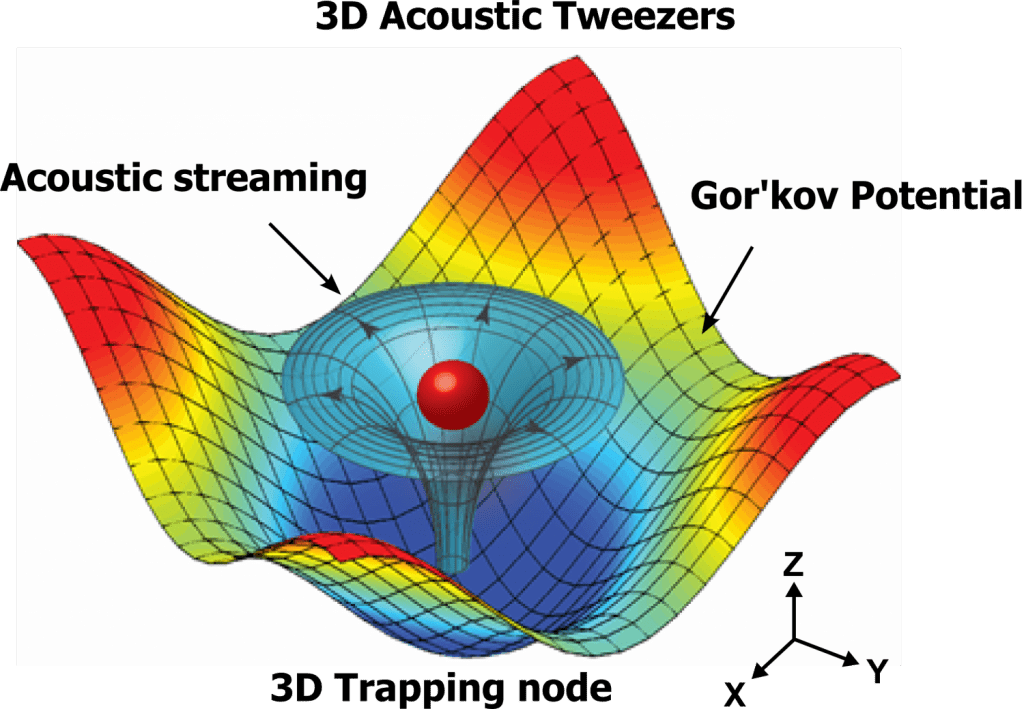Researchers found a way to manipulate single cells in three dimensions using sound waves. They devised acoustic tweezers that can position minute particles or cells anywhere within the fluid enclosure without touching, altering, deforming or labeling the particles in any way. The resolution or accuracy is between 1-2 micrometers. Work like this might enable us to design tissue implants which faithfully mimic the human tissues or organs destined to be replaced. Other methods, like 3D biological printing, alter or even destroy cells keeping them from functioning the way they ought to.

Numerical simulation results mapping the acoustic field around a particle that shows the physical operating principle for the 3-D acoustic tweezers. The 3-D trapping node in the microfluidic chamber is created by two superimposed, orthogonal, standing surface acoustic waves and the induced acoustic streaming. Credit: Tony Jun Huang, Penn State
The setup is based on a microfluidic device researchers from MIT, Penn State University, and Carnegie Mellon University previously developed. It uses two sources that each produces a standing acoustic wave — waves of constant height. When the two meet, they form a node whose pressure traps a particle. By altering the phase and amplitude of the wave, the particle is moved in 2D along a X-Y axis. Using this method, researchers separated cancerous cells from healthy cells, something that might prove very useful in diagnosing rare forms of cancer.
Most recently, the setup was upgraded so that particles could be positioned in 3-D. Polystyrene particles as well as mouse fibroblast cells were moved vertically by the researchers by altering the acoustic waves’ power (rate at which sound energy is emitted).
“The results presented in this paper provide a unique pathway to manipulate biological cells accurately and in three dimensions, without the need for any invasive contact, tagging, or biochemical labeling,” says Subra Suresh, president of Carnegie Mellon and former dean of engineering at MIT. “This approach could lead to new possibilities for research and applications in such areas as regenerative medicine, neuroscience, tissue engineering, biomanufacturing, and cancer metastasis.”

Formation of arbitrary cell culture patterns forming a “3,” “D,” “A.” and “T” by printing of single HeLa S3 cells via 3-D acoustic tweezers. Credit: Tony Jun Huang, Penn State.
The setup has 1 micrometer accuracy horizontally and 2 micrometer accuracy vertically. In experiments, particles as large as 10 micrometers were basically moved at a pace of about 2.5 micrometers per second. It takes between a couple of seconds to a few minutes for a cell to be placed in the desired position, depending on the distance.
“Adding a third dimension for precisely manipulating single cells for bioprinting further advances acoustic tweezers technology,” said Ming Dao, director, Nanomechanics Lab, Massachusetts Institute of Technology. “The accompanying modeling provides solutions for cell manipulation, enabling validation of the method as well as possible system optimization.”
“3-D acoustic tweezers can pattern cells with control over the number of cells, cell spacing and the confined geometry, which may offer a unique way to print neuron cells to create artificial neural networks for neuron science applications or regenerative neuron medicine,” said Tony Jun Huang, professor and The Huck Distinguished Chair in Bioengineering Science and Mechanics.
Using the setup, researchers stacked cells together which makes it a form of bioprinting. Findings were reported in PNAS.
“This is an exceptionally innovative approach of manipulating particles and single cells in 3-D in fluids,” says Taher Saif, a professor of mechanical science and engineering at the University of Illinois at Urbana-Champaign, who was not part of the research team. “Since acoustic energy is used for this manipulation, the approach is noninvasive and the cells maintain their viability. Overall, the method presented will be of significant interest for a broad community, from biologists to bioengineers.”









